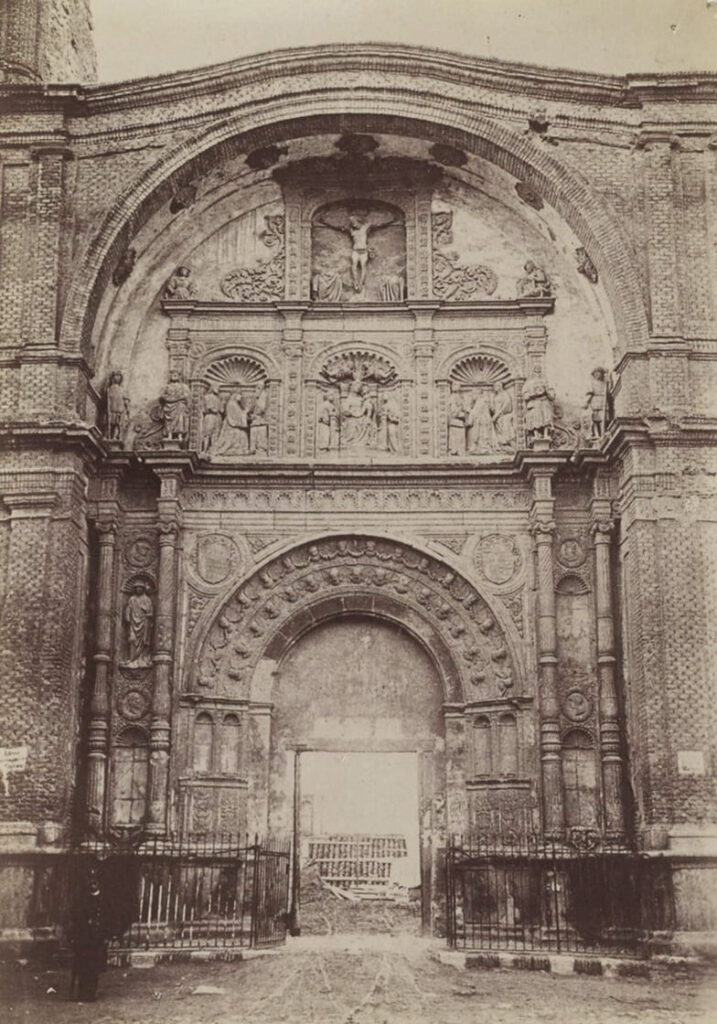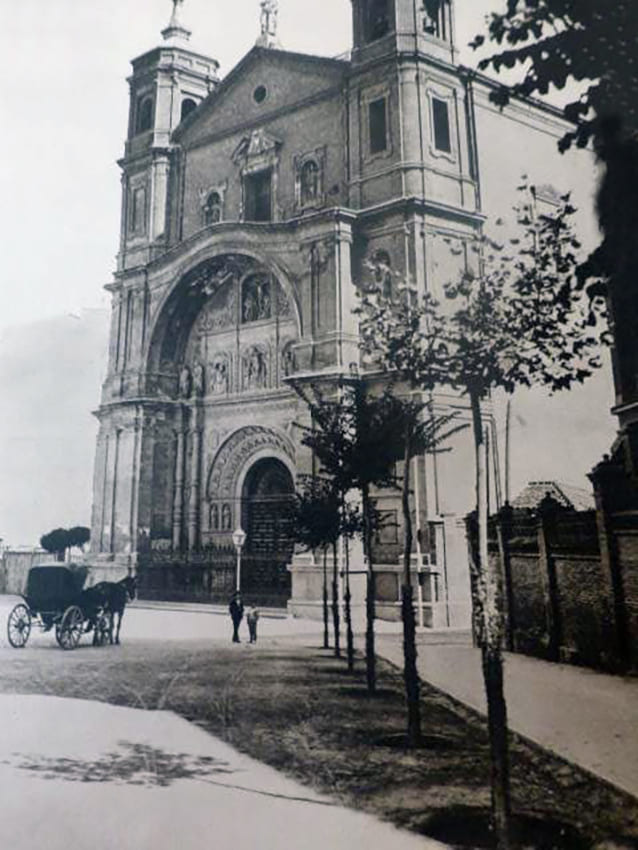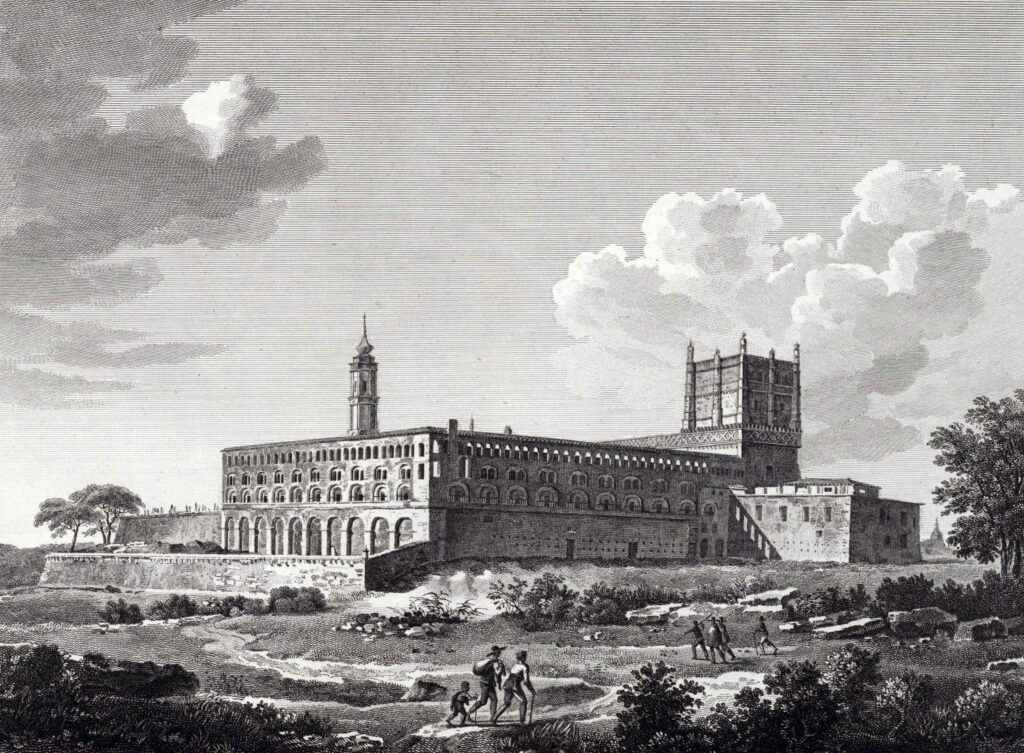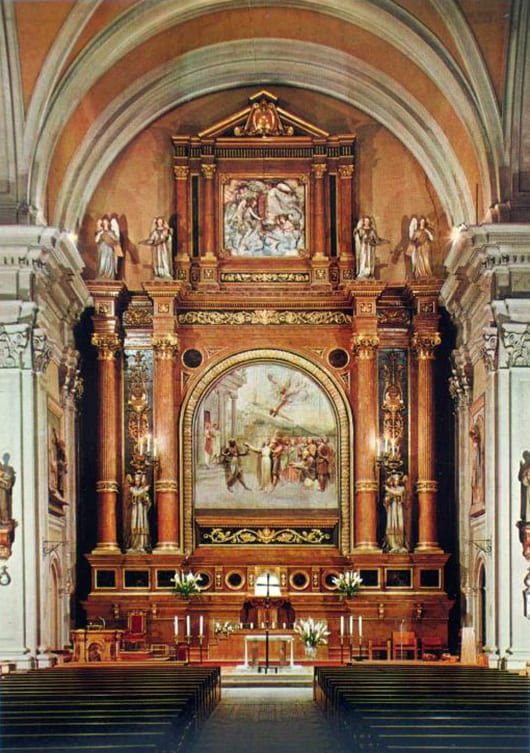SAINT ENGRATIA (ZARAGOZA)
Write version
Dear visitor, welcome to Zaragoza and its Basilica of Saint Engratia. You are in a temple built thanks to the deep faith and great devotion of the people of this city towards their patron saint and her companions, martyrs in the Faith. According to tradition, Saint Engratia was a young Lusitanian woman who suffered martyrdom in the 4th century in the ancient Caesar Augusta, name of Zaragoza in Roman times. Along with her, her eighteen companions who accompanied on her journey to go to marry south of Gaul were also martyred.
This temple has kept alive the memory of her, as well as the devotion to her relics. Also known as the Sanctuary of the Innumerable Martyrs and the Temple of the Holy Masses, it has been visited over the centuries by numerous pilgrims and visitors.

“The Napoleonic armies invaded Zaragoza demolishing the monastery of Saint Engratia, but they could not destroy the veneration of the holy martyrs who continue victorious in their mission of being exemplary witnesses of following Jesus Christ”
THE OUTER FAÇADE
Before entering the temple, we contemplate its monumental main façade. It is Plateresque in style and constitutes one of the most relevant Renaissance works in Spain. Philip II defined it as “a high altar moved to the façade”. The original façade was erected in 1511 by Gil Morlanes the Elder and completed in 1516-1517 by his son, Gil Morlanes the Younger. In the middle of the 18th century it underwent a new restoration until in 1899, Carlos Palao intervened on it for the third time as we can see it today.
In this majestic cover we see the martyrdom character thanks to an ascending iconography; from the triumph of the martyrs for their Faith in Jesus Christ to the wisdom of the Doctors, pillars of the Church. Above them, the Virgin appears with her Son, venerated by the kings of the earth. The whole set is topped by Calvary, a sign of Redemption.
The façade opens in a semicircular arch, with two archivolts and is flanked by sculptures of confessors and holy martyrs. On the right, the carving of Saint Stephen carrying the stones with which he was stoned. He is called “protomartyr”. Beside him we see the effigy of Saint Valerius, one of the first bishops of Zaragoza and patron saint of the city. On the left are the images of Saint Prudencio, and Saint Vincent the martyr, the deacon of Saint Valerius, who is accompanied by a millstone with which he was thrown into the sea, a symbol of his martyrdom.
The façade is framed by two pairs of balustraded columns. Among them are the sculptures of the Doctors and Fathers of the Church. In the lower right niche we can see Saint Augustine carrying “De Civitate Dei” -The City of God-. In the upper niche, we see the carving of Saint Gregory the Great. On the opposite side, at the bottom appears the effigy of the Bishop of Milan and mentor of Saint Augustine, Saint Ambrose. Above him, Saint Jerome holds a book, possibly “The Vulgate”. It is a translation of the Bible into Latin that he authored. At his feet rests a lion, a figure that always accompanies him in his iconography.
The upper niches house three reliefs. The central one is occupied by Saint Mary of the Holy Masses, seated on a throne with the Child Jesus standing on her lap. A pair of angels playing her instruments flank her, while two others crown her as Queen of heaven and earth. On the sides we distinguish the reliefs of the Catholic Monarchs in a praying attitude. On the right, Queen Isabella the Catholic kneeling with a rosary in her hands, fixing her gaze on the Virgin and Child who presides over the ensemble. She is accompanied by Saint Catherine of Alexandria, who seems to be holding her cloak, and Saint Paula, founder of the female branch of the Order of Saint Jerome. The sculpture of King Ferdinand the Catholic with the same devotional disposition as his wife occupies the left niche. Saint Jerome, founder of the Order of Saint Jerome, and Saint John the Baptist covered in camel skin accompany him. In the 15th century, the church of Saint Engratia became a monastery of the Jerome Order. For this reason, Hieronymite devotion and iconography abounds.
“King Don Juan, the second of those of Aragon, father of our King Ferdinand the Catholic, had great devotion to the virgin and martyr Saint Engratia. He got a very severe disease in his eyes while he was in Zaragoza in the year MCCCLIX. Truly entrusting himself to his saint and then he recovered health and the sight that had almost lost it…, and he wrote a letter earnestly begging the Order of Saint Jerome, that he wanted to receive the Church of Saint Engratia for the monastery of the Order, because he intended to make a main monastery there.”
At the ends, two figures dressed in military clothing seem to guard this second body. Next to them, the effigy of Saint Lambert carrying his head in his hands. Legend has it that this saint from Zaragoza, patron saint of Aragonese farmers, deeply admired the example of love for God shown by Saint Engratia and her companions. For this reason, after suffering martyrdom by beheading, he took his head in his hands and went to this sanctuary to be able to rest in peace with his beloved martyrs. On the left side, we can see Saint Lupercio, Saint Engratia’s uncle, who headed the court of the Eighteen Knights that accompanied the young woman to Caesar Augusta.
Finally, the complex is crowned by a magnificent Calvary with its usual iconographic composition. On the left, the Sorrowful Virgin raises her gaze to her Divine Son, while Saint John, her beloved disciple, looks with sorrow at her Lord.


“For God did not send his Son into the world to be its judge, but to be its saviour”
Saint John 3, 17
After contemplating this lavish façade, it is time to access and delve into this place full of history, art and devotion. As you can see, it is solemn and spacious and everything leads us to focus our attention on the main altar.
MAIN NAVE AND SIDE CHAPELS
Begin your tour inside the main nave of the temple rebuilt at the end of the 19th century. Its construction is the result of interventions carried out in the 19th century by the architects Ricardo Magdalena and Julio Bravo. As you advance through the central aisle to the main altar, you will discover large labels with bronze letters on the floor with the names of the companions who, together with young Engratia, suffered martyrdom. We know their names written on the pavement of the central aisle of the main nave, thanks to the testimony of the Roman poet Aurelio Prudencio, who around the year 405 dedicated the fourth hymn of his work “Peristephanon” or “Book of Crowns” to the martyrs of the city.
THE NAMES WERE:
Januario, Fausto, Casiano, Matutino, Apodemio, Primitivo, Evencio, Quintiliano, Publio, Frontonio, Felix, Ceciliano, (Lamberto – next to the descent to the crypt), Julio, Urbano (here you can look up at the painted cover), Marcial, Suceso, Optato, Countless martyrs, Lupercio, Engratia.
Surely your attention has already stopped at the imposing 19th century painting that decorates the vault of this section. In its lower part, Saint Engratia is represented being martyred inside a pagan temple in the presence of the Roman governor. If you look at the scene you will discover how a soldier carrying large pincers opens the side of the young martyr, revealing her entrails as narrated by Aurelio Prudencio in the Peristephanon. At the top, the scene of the glorification of the martyrs appears.
THE MAIN ALTARPIECE
Presiding over the main altar, suspended under a crown, we see a Crucified Christ. It was made in 1892 by the Catalan sculptors, of modernist orientation, José Llimona and Eusebio Arnau. The relief of the central body of the altarpiece was made by Arnau, while the sides were executed by Llimona. In the general composition, it can be seen that two angels flank the splendid high relief in the central part that represents the Martyrdom of Saint Engratia at the time of her death. In the scene, again at the gates of an ancient pagan temple, an executioner martyrs Saint Engratia by driving a nail into her head in the presence of the governor and the faithful of Zaragoza. The nail is the attribute of her martyrdom and the emblem of this temple. In 2011 it was restored recovering the current polychromy.
Arrived at this place, take a good look at the Tabernacle. There is the greatest treasure that we find in the temple: the Eucharistic Presence of the Lord. Living Christ has freely saved and redeemed us, he has given us eternal life and is always with us. You can stop before Him and raise a short prayer.
THE EPISTLE SIDE (right)
At this time you can return to the beginning of the temple to contemplate the side chapels.
Under the choir and separated from the rest of the temple by a lattice, there is an imposing white marble baptismal font covered by an original lid. Next, in the next chapel, is the altarpiece dedicated to Saint Anthony of Padua, one of the few saints represented with the Child Jesus in his arms. The carvings of Saint Helena and the Apostle Saint Thomas complete the ensemble.
The processional carving of “Jesus on the way to Calvary” is next to the door that gives access to the crypt. On it, the image of the Divine Mercy. Jesus radiates red and white light from his heart, which represent the Blood and Water that flowed from the depths of his Mercy.
The last ornamental work on the right side of the temple corresponds to the altarpiece of Saint Lawrence, whose image with the grill and symbol of his martyrdom presides over the set. Saint Aloysius Gonzaga and Saint Rita of Cascia are next to it, while a relief of the Archangel Raphael occupies the attic. The effigies of the Fathers of the Church, Saint Jerome and Saint Augustine, escort this group of sculptures.
We arrived at the head of the temple. The bronze images of Saint John Paul II and Saint Josemaría Escrivá by the Madrid sculptor Diana Garcia Roy are at the foot of the main altar. The Pope venerated the Holy Masses, relics of the Innumerable Martyrs, during his visit to Zaragoza in 1982 and granted the temple the dignity of minor pontifical basilica. For his part, the founder of Opus Dei celebrated Mass in this sacred area. At the height we can distinguish the carvings of Saint Lawrence and Saint Vincent Martyr.
“The martyrs wish to be in communion with the Truth and show it with their sacrifice. With his death they are united to Christ, because He is the Way, and the Truth, and the Life.”
THE GOSPEL SIDE (left)
Following the route you will find the Altar of the Three Hail Marys. It is a delicate relief where the Coronation of Mary is represented. The Virgin Mary is crowned by the Holy Trinity as Queen of the Universe. In the same way, the set is flanked by the carvings of Saint Peter Nolasco and Saint Joseph Calasanz.
Next, you find the processional float of Holy Week “Jesus falls the first time”. The altarpiece in the adjoining chapel is dedicated to the Holy Family of Nazareth. The Virgin Mary and Saint Joseph accompany the Child Jesus who rests his feet on the globe. The Holy Spirit in the form of a dove protects them. The whole set is crowned by the figure of the Eternal Father.
In the next chapel, we discover the altarpiece of the Sacred Heart of Jesus. It is accompanied by the smaller images of Saint Teresa of Avila and Saint Henry.
Finally, there is the chapel of the Crucified, where we can see a sober carving of Christ Crucified, made by Carlos Palao. It is accompanied by a simple image of the Virgin of Sorrows.
At this point, surely you have noticed some simple reliefs with the fourteen stations of the VIA CRUCIS with twelve crosses that are on the walls. The way of the cross of Jesus is the prelude to the definitive triumph over death that will come with his Resurrection.
ANTEHALL TO THE CRYPT
At this time of the visit you can access the crypt by going down the stairs that are next to the image of “Jesus carrying the cross”.
The crypt is located in the archaeological space that corresponds to the old sanctuary where the remains of Saint Engratia and the Eighteen Martyrs were venerated, already mentioned by Aurelio Prudencio in his work from the beginning of the 5th century. At the end of the stairs and at the entrance of the crypt, you can also see the archaeological remains of a Baptistery or ancient baptismal pool associated with the primitive sanctuary from the 5th-6th century. It was octagonal and in the centre there was a small pool where baptism was carried out by the rite of immersion. On top of it, a Roman architectural element reused and later converted as a baptismal font in the Middle Ages in which baptism was carried out through the rite of infusion, a rite that replaced that of immersion. In this same place, an image of Saint Engratia stands out, which presided over the façade of the temple and which, after its restoration, was replaced by the one that we can see today in its place.
THE ACCESS TO THE CRYPT
Upon entering the crypt, contemplate the original flooring of the ancient sanctuary from Roman times and the extension that was carried out in the medieval monastery.
The crypt, designed by the architect José de Yarza, rebuilt after its destruction in 1808, had a long genesis. First, the removal of debris produced by the blasting of it by the French army and then, its reconstruction. Throughout the 20th century there have been some small reforms and in 2011, archaeological excavations. Being the privileged place of the current basilica, the veneration of the relics of the martyrs is practically uninterrupted. For this reason and to respect the people who come to pray, if there is no religious worship, you can access the sacred space of the crypt, the origin of the current temple. You will see relics of Saint Engratia and the Eighteen companions, Saint Lambert and the Holy Masses. Also relics that are found inside the arches attached to the wall and that surround the faithful who make the pilgrimage here interceding to promote a closer experience of the presence of God in this space.
THE CENTRAL CORRIDOR
Approach the presbytery. The Well of the Innumerable Martyrs of Zaragoza is located there, which contained the remains of their martyrdom relics. Tradition has it that, next to the ancient Cinegia Gate of the city, other Christians from Caesaraugusta were also martyred by the Roman governor. Some small caked ash stones, Holy Masses, that were collected in this place remind us of the testimony of these Christians.
Now go to your left. A large chest guards the main relics that have come down to us. The reliquaries that house the skulls of Saint Engratia, Saint Lupercio and Saint Lambert; the martyrdom nail of Saint Engratia; the cloth that keeps the blood that miraculously gushed from the skull of Saint Lambert in 1522 when Pope Adrian VI visited this place; and the Holy Masses that remain from the well of the Innumerable Martyrs. We can also find the Holy Masses inside the small chest on the other side of the crypt and which Saint John Paul II venerated in 1982 on his trip to Zaragoza.
THE MAIN ALTAR
Decorating the main altar you will see a set of sculptures from the 15th and 16th centuries belonging to various altarpieces. The central figure represents Saint Engratia. The carvings that flank it are characters whose identities we explain below. Looking straight at the altar, the group on the right stands out because it represents the figure at the end of Charles V with the Golden Fleece. The next figure is his brother Ferdinand, King of Bohemia and Hungary. The figure that is in the middle of the two, in the background, Francisco de Cobos secretary of state of the Spanish Monarch. If we go to the group on the left, the bearded figure with a covered head at the bottom of the group is the sculptor Damián Forment.
Also on the main altar you will find three sarcophagi attached to the wall. The two ends are made of carved marble and the central one is made of Tortosa jasper. The first two housed relics of the martyrs from the Hispano-Visigothic period (VI-VII centuries) and the central one contained the remains of the martyr Engratia from the middle of the 3rd century.
THE PALEOCHRISTIAN SARCOPHAGUES
On both sides of the altar you will find two early Christian sarcophagi carved in the workshops of the city of Rome around the years 330 and 340. On the right, the one known as the “Receptio animae” or of FLORIA, the name engraved in the centre of the top fillet. It housed the relics of Saint Engratia from the 6th-7th centuries until they were hidden at the end of the 11th century in the limestone sarcophagus that you can see under the modern main altar. On the sides, original sin and the expulsion of Adam and Eve from Paradise are represented. The main frieze represents the judgement of the soul and the prize of heaven. The next two scenes are: the healing of the blind man and the Wedding at Canaa. It is carved in Marble of Proconeso (Sea of Marmara) and dated around 330.
On the left, the sarcophagus called the “Petrine Trilogy” represents four miracles of Jesus Christ: the healing of the blind man, the wedding ceremony at Cana, the miracle of the loaves and fishes, and the resurrection of Lazarus. And three scenes from the life of Saint Peter: the baptism of his jailers in Rome, the arrest of Jesus and Peter’s denials. It is carved in Greek marble from Paros and can be dated to around 340.
All these images are of great spiritual value for the first Christian communities in the city. When you see them, you will be able to travel back in time and contemplate the same figures that fed the faith of the first Christians.
To end the visit and before leaving the crypt we will observe the shaft of a column. Most likely it is from the primitive Romano-Christian basilica of the 4th century that was reused in the medieval Monastery that occupied this same place. The tradition of the place affirms that, in this column, Saint Engratia was whipped.

“Jesus is alive among us, He is the same yesterday, today and forever”
We are finishing our visit where we have combined art and faith. We hope your visit has been pleasant. Before leaving the temple to continue on your way through Aragonese lands, we invite you to have a few moments of recollection and prayer. You can accompany the Lord in his Eucharistic presence in this same crypt together with the relics of the Martyrs of Zaragoza. They are the ones who teach us the value of faith and the testimony of life despite the difficulties, resignations or persecutions that we may suffer. His example and his life is the seed of new Christians.
We put at your disposal some prayers that we hope will help you in these moments of internalization. In the same way, thanks to the various links in the text, you can delve into the lives of the Saints located in the altarpieces of the Basilica.
PRAYERS
Show me the way (St. Augustine)
Now I understand the need to return to you.
Open the door for me, because I am knocking.
Show me the way to reach you.
I only have will.
I know that what is expired and transitory must be despised in order to go after what is safe and eternal.
This I do, Father, because this is what I only know and I still do not know the path that leads to you.
You teach me, you show me, you give me the strength for the trip.
If with faith those who seek you come to you, do not deny me faith.
If it comes with virtue, give me virtue.
If it comes with science, give me science.
Increase faith in me, increase hope, increase charity.
Oh, how admirable and singular is your goodness!
Prayer to Saint Engratia
God of love and providence.
You gave us Saint Engratia as a testimony of faith and strength.
Make us have faith in you and also have strength to face the barriers of every day.
Through Jesus Christ, Our Lord. Amen.
Prayer of Pope Francis for persecuted Christians
Our Father, merciful and loving Father, look at your sons and daughters who, because of their faith in your Holy Name, suffer persecution and discrimination in so many parts of the world.
May your Holy Spirit fill you with his strength in the most difficult moments of persevering in faith.
May it make them capable of forgiving those who oppress them.
May it fill you with hope so that you can live your faith in joy and freedom.
May Mary, Help of Christians and Queen of Peace, intercede for them and guide them on the path of holiness.
Heavenly Father, may the example of our persecuted brothers
increase our Christian commitment.
May it make us more fervent and grateful for the gift of faith.
Open, Lord, our hearts so that with generosity we know how to support them and show them our solidarity.
We ask this through Jesus Christ our Lord. Amen.
